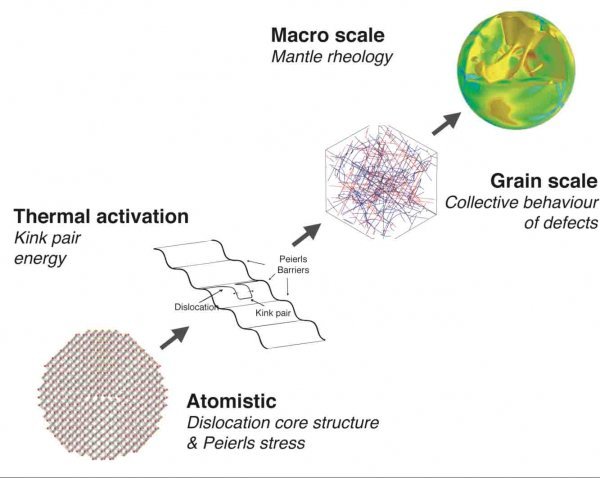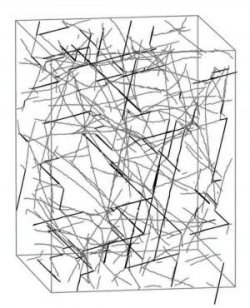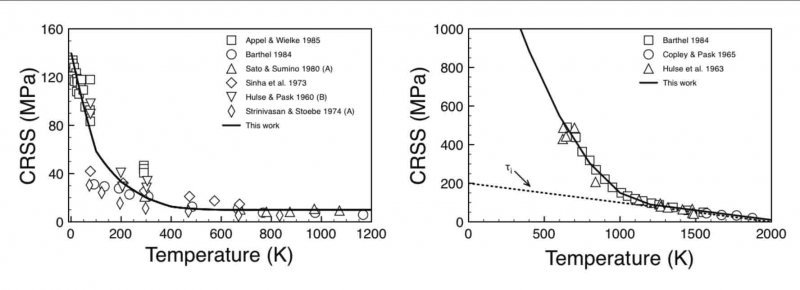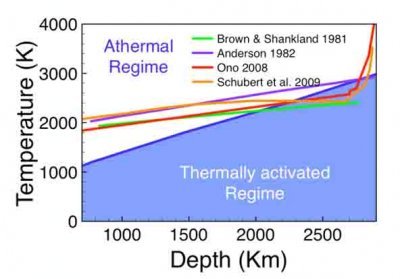RheoMan: a five-year, ERC-funded (Advanced Grant), project to model the rheology of the Earth's mantle
Dec 15, 2011 The roots of RheoMan Results
Jonathan Amodeo's PhD thesis
Until recently, deformation of minerals under high pressure could only be investigated through large volume press or diamond anvil cell experiments. In spite of significant technical improvements, these approaches remain extremely challenging because of pressure, temperature and especially low strain-rates conditions prevailing in the deep Earth.

During J. Amodeo PhD thesis, we developed a numerical multi-scale approach of MgO single crystal plasticity (MgO is the magnesium end-member of ferropericlase, second most important phase in volume and mass of the lower mantle, after the magnesium silicate perovskite phase), from laboratory conditions to those of the Earth's mantle. Here we summarize this work which set the basis for the Rheoman project. This work has been mainly organized in two parts (i) the build-up of the multi-scale model and its validation against the available experimental data at ambient pressure (ii) the use of the model in order to describe MgO plasticity in the Earth's mantle conditions of pressure, temperature and strain-rates.
Our multi-scale approach is made of three hierarchical numerical steps. The first one corresponds to the calculation of dislocation core structures, at the atomic scale, using the Peierls-Nabarro-Galerkin method. Results confirm that ½<110>110 is the easiest slip system with a Peierls stress of 150 MPa for the screw dislocation. ½<110>100 slip system, the second glide system family of the rock-salt structure, exhibits a Peierls stress above one GPa for the screw dislocation. For both glide systems, calculations for the edge dislocations yield lower stresses of the order of a few tens of MPa.
The second calculation step consists in modeling the thermal activation of dislocation glide using the kink pair theory. This method allows to determine the activation enthalpy ΔH(τ) needed by the dislocation to overcome lattice friction under the influences of both stress and temperature. Doing so, one may deduce a thermally activated mobility law v(τ,T) for dislocation glide. Results for the screw dislocation velocity at ambient pressure are in good agreements with experimental velocity measured in the most pure MgO samples.

Finally, the last step calculation is based on Dislocation Dynamics (DD). The mobility law inferred from the kink pair theory, parameterized at the lower scales, have been implemented in microMegas (DD code developed in the LEM laboratory, Châtillon France) and simulations have been performed in order to investigate the collective behavior of dislocations as a function of the temperature. Two deformation regimes have been clearly identified (i) below a critical temperature Ta, MgO single crystal deformation is thermally activated and is governed by the continuous glide of long screw dislocations. To a first order, one may deduce the flow stress (Stage 1) using Orowan equation (ii) above Ta, flow is governed by local interactions between dislocations (forest interactions). In this last regime, the shear stress is thus temperature-independent and is called athermal stress. We used DD calculations in order to define the Critical Resolved Shear Stress (CRSS) for both glide systems of MgO and to investigate some microstructural aspects linked to dislocation interactions (strain hardening, HT discontinuous glide). Our results are in good agreement with experimental observations.

After this validation stage, the multi scale approach has been applied to mantle conditions for pressure, temperature and strain-rate. Under pressure (up to 100 GPa), dislocation core structures evolve leading to an increase of lattice friction. This property has strong implications on CRSS which are higher at high pressure than at ambient pressure. A slip system transition is also estimated around 30 GPa ; ½<110>100 slip system becomes "easier" at high pressure. Under pressure and at laboratory strain-rate range, MgO deforms within the thermally activated regime (lattice friction regime), under high stresses. Calculations performed in the Earth's mantle range of strain-rates lead to markedly different results. The decrease of the strain-rate toward 10-16 s-1 shows that the CRSS are lowered and that the thermally activated regime is narrowed ; at 10-16 s-1 strain-rate, MgO deforms mainly in the athermal regime, under low stresses. Strain-rate is thus a key parameter which has to be taken into account in order to describe the rheology of mantle minerals.

This work emphasizes that it is now possible to model minerals plasticity under mantle conditions of deformation. It also underlines the effect of strain-rate on the deformation mechanisms of minerals, in a range which is not accessible by experiments.

